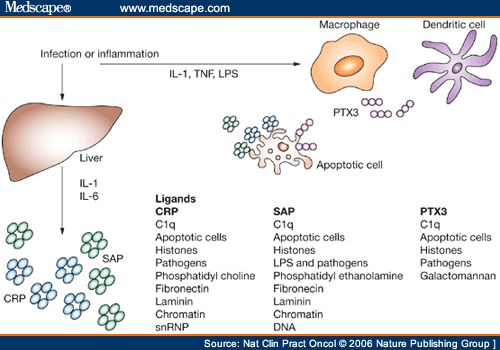C-reactive protein (CRP) is a plasma protein of the pentraxin family . It is an acute phase protein.
 Large picture
Large picture
SYNTHESIS
CRP is essentially produced by the liver in response to the presence in bloodstream of inflammatory cytokines.

These proteins,in particular: IL-1, IL-6, IL-8, TNF-α(indirectly) etc.. are released by local inflammatory cells, like neutrophil granulocytes and macrophages, during an injury (infective, neoplastic, traumatic,...).IL-6 has a key role in mechanism of CRP activation and other molecules are also stimulated by this cytokine: fibrinogen in particular.
Normal concentration of CRP in the blood is less then 1 μg/ml but the concentration can increase drammatically up to 1000 times after tissue injury. The spike of CRP concentration in bloodstream is after 24-48 h but the increasing can be observed after 6 hours.
TGFβ inhibites the synthesis of CRP while Neutrophil proteases induce degradation.
What about the high concentration of mRNA in Pancreas?
FUNCTION
CRP is one of the main acute phase proteins. It performes its function binding many substrates with Ca-dependent bonds. Its binding with cells and nuclear fragments contributes to prevent a long time inflammation and self reactions with nuclear antigens.
Main functions:
- binding and activation of Complements (C1q)
- modulation of platelets activation
- increases of chemotaxis and phagocytosis
- increases natural killer action
- increases macrophages action against tumors
- opsonization(by phosphorylcoline binding)
Diagnostic use of CRP is very important because it is one of the main markers of inflammation. Measuring CRP is useful to value the progress of disease and the effectiveness of treatments.
Measuring of CRP is performed by a specific test
PATOLOGIC EVENTS CORRELATED WITH CRP INCREASED CONCENTRATION
- bacterial infection (blood poisoning, meningitis, pneumonia, tbc...)
- viral infection (hepatitis, mumps..)
- parasitical infection (malaria, toxoplasmosis, pneumocistis carinii..)
- inflammatory non infective (RA, crohn disease, fracture, traumatic events, surgery, burns..)
- necrotic events (heart stroke, acute pancreatitis)
- neoplasia (HL, K kidney, K prostate gland, K bladder)
Many studies also correlated CRP with risk of cardiovascular disease during methabolic syndrome
It’s important to consider that in some case the CRP growth is not linked to the primary patology. For example in LES and Leukaemia increasing of CRP can means that the patient contracted a bacterial or viral infection, during the main disease.